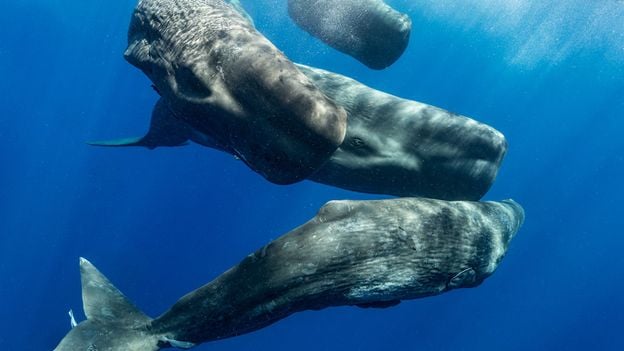Sperm whales communicate with each other using rhythmic sequences of clicks, called codas. It was previously thought that sperm whales had just 21 coda types. However, after studying almost 9,000 recordings, the Ceti researchers identified 156 distinct codas. They also noticed the basic building blocks of these codas which they describe as a “sperm whale phonetic alphabet” – much like phonemes, the units of sound in human language which combine to form words.
Pratyusha Sharma, a PhD student at MIT and lead author of the study, describes the “fine-grain changes” in vocalisations the AI identified. Each coda consists of between three and 40 rapid-fire clicks. The sperm whales were found to vary the overall speed, or the “tempo”, of the codas, as well as to speed up and slow down during the delivery of a coda, in other words, making it “rubato”. Sometimes they added an extra click at the end of a coda, akin, says Sharma, to “ornamentation” in music. These subtle variations, she says, suggest sperm whale vocalisations could carry a much richer amount of information than previously thought.
Squid, on the other hand, are fast.
Goddamn right we are.
I had a marine mammal prof in college who was fiercely dull unless you got him talking about whale hunting techniques. He would get particularly animated when describing how a Sperm Whale click carries enough force at depth that it make luminescent squids “light up like ‘eat me’ signs.”
He also did a fun impression of a Grey Whale scooping mud off the sea floor. Which was mainly memorable because it was like watching Niles Crane pretend to be a backhoe.
He also did a fun impression of a Grey Whale scooping mud off the sea floor.
Was he voiced by Ellen DeGeneres?
Fast and bulbous.
Staring the rock as jacked squid cop who’s also a professional wrestler
Damnit, back in the cage with you!
It has TWO locks this time, asshole!
Gone in squidxty seconds.
deleted by creator
We’re about to learn how much they fucking hate us.
Get in line and take a number
I have a feeling if we ever get to speaking with whales they are going to have a lot of words for us.
And I wouldn’t be surprised if nearly every one was unkind. Deservedly so.
“I think the translator is broken. it’s just beeping noises”
“Ah. no. That’s the automatic swear word filter kicking in”
‘I can think of two they might say to the human species, ‘fuck’ and ‘you’ in whale equivalent speech.
I know it’s a general consumption news story, but I wish they’d have at least included a name or basic description of what the “AI” used was. “AI” is about as blandly unspecific as you can get even if it’s only being applied to algorithms that fall into that broad category, let alone how commonly it’s misused nowadays.
Clippy. The AI was Clippy.

It bothered me too so I clicked on the highlighted link in the article and in that there are these tidbits.
The data collected has been processed using machine-learning algorithms to detect and classify clicks, with results due to be published in 2024.
And
More than 5,000 miles (8,000km) away, a group of artificial intelligence and natural language processing experts, cryptographers, linguists, marine biologists, robotic experts and underwater acousticians are also hoping to use AI – this time to decipher sperm whale conversation.
Emphasis mine
I hope to master all of time and space … but I don’t have a plan nor any motivation to do so. Where’s my article?!
https://dune.fandom.com/wiki/Orange_Catholic_Bible
Then you just have to become the Kwisatz Haderach
Drat, now I’m trapped in a web of my own prophecy. I should have seen that coming.
I think that’s a link to a different group. The study they link in the first article is more direct data analysis.
Yeah, it’s so commonly misused that I tend to just equate it to some sort of machine learning algorithm. Which is really just some complicated statistics and a database in a trenchcoat.
ML is in the category of AI, IMO. This was just scientific data analysis though, dressed up with the buzzword. It’s the right tool for the job and looks like good work, but not AI. Which is fine. I don’t get why people feel the need to call “doing something with data on a computer” AI.
Here is the paper … https://www.nature.com/articles/s41467-024-47221-8
I skimmed it and it seems Methodology (near the bottom of the paper) has some info. They also have 2 links to github for the data and custom scripts used.
Sorry, this is way out of my range of understanding. Hoping it helps.
It does! This isn’t anything that I’d call AI. It’s cool work, but it was just regular old scientific analysis and data visualization. Buzzwords strike again.
I’d be blaming the BBC and journalists/editors for that mess then.
Glad you got the info you wanted tho. 👍
Someone found a little AI in one of the code cells. Pretty low-level stuff, but it was used a little bit.
deleted by creator
Probably unsupervised learning, specifically! So maybe some kind of k means clusters based off characteristics of the sounds
edit: got it in one baybee
That’s the thing, dude, when you write software…it doesn’t have a name. They probably started with a framework like tensor flow and then stacked audio analysis ml modules on top figuratively, but this was probably mostly written in house it’s not a commercial product.
I’m in “artificial intelligence” and write software. I’m not looking for a product name. If they developed an entirely new technique that’d also be cool to mention, but they probably built on existing techniques and were at least working in some broad form of AI.
Edit: After looking at the paper, it’s the “misused” category. They were doing regular scientific data analysis.
The github shows them doing some k nearest neighbors and kernel estimation as part of their understanding of the coda (I think? I don’t know anything about whales)
The KMeans is actually an unused import, but yeah, I see the kernel estimation. They also use a gaussian mixture in one of the lower cells. So a little AI.
Whales can have a little AI as a treat :3
When we get to the point of communicating with them, will I get in trouble for telling them to sink yachts?
sperm hehe
Are you ready to hehe more? The whale is named after the waxy/oil substance called spermaceti that is extracted from their heads. Spermaceti means “whale sperm”… Because, for some reason, it was thought that that was what it was
So piss is stored in the balls and sperm is stored in the head? Knowledge !
must have been a greek dude to name it lol
Hehe
deleted by creator
Hehehehehhe
There’s a later report where they’ve deciphered one of the oft repeated sperm whale sentences: “So long, but why no fish?”
Imagine reading the title of this article to yourself as a child.
I can imagine reading the ‘sperm’ part as a child…

When I was a child in the late 80s, I saw the occasional news story about researchers trying to crack the code in whale communication. Crazy that we might get there.
I love reading these updates every couple years.
So psyched to talk to whales.
Just give the person a citizenship
This is the best summary I could come up with:
Now, from elephants to dogs, modern technology is helping researchers to sift through enormous datasets, and uncover previously unknown diversity and complexity in animal communication.
They also noticed the basic building blocks of these codas which they describe as a “sperm whale phonetic alphabet” – much like phonemes, the units of sound in human language which combine to form words.
Pratyusha Sharma, a PhD student at MIT and lead author of the study, describes the “fine-grain changes” in vocalisations the AI identified.
The existence of a combinatorial coding system, write the report authors, is a prerequisite for “duality of patterning” – a linguistic phenomenon thought to be unique to human language – in which meaningless elements combine to form meaningful words.
Categorised as “vulnerable” by the International Union for Conservation of Nature (IUCN), sperm whales are still recovering from commercial hunting by humans in the 19th and 20th Centuries.
– If you liked this story, sign up for The Essential List newsletter – a handpicked selection of features, videos and can’t-miss news, delivered to your inbox twice a week.
The original article contains 1,360 words, the summary contains 179 words. Saved 87%. I’m a bot and I’m open source!
love how the newsletter registration CTA was aparently important enough to not shorten
I’ve blocked that useless bot.










